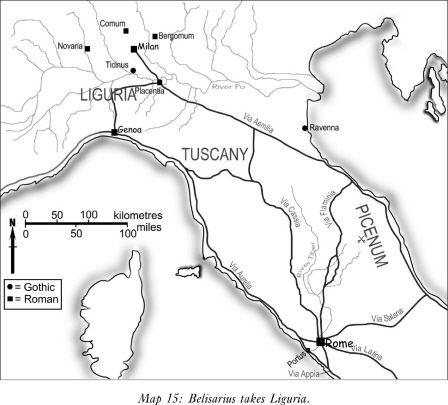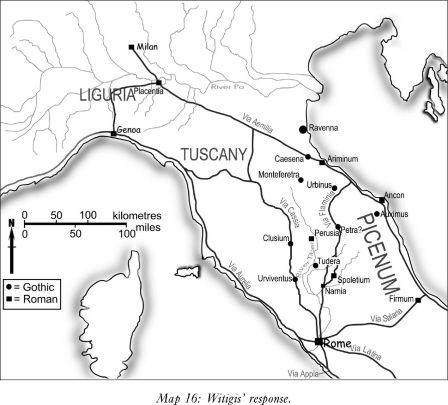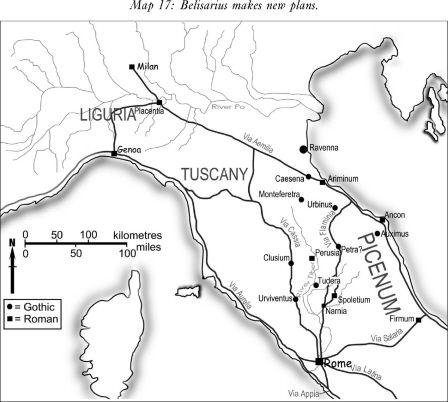Belisarius: The Last Roman General (35 page)
Read Belisarius: The Last Roman General Online
Authors: Ian Hughes

Politically weakened by the loss, the Byzantines moved on and finally entered Milan. They sent small garrisons to the neighbouring cities of Bergomum, Comum and Novaria, plus other strongholds, in order to secure the whole of Liguria for Rome.
When Witigis learned of the defection of Milan, he sent a large army under the command of his nephew Uraias to lay siege to the city. In accordance with their agreement, the Franks sent 10,000 Burgundians to assist Uraias in the siege, although Procopius may have exaggerated the strength of the Burgundian force. No Franks participated, since they were still supposed to be allied with the Byzantines against the Goths.
In Milan, Mundilas prepared to face the Goths. But, as he had left garrisons throughout Liguria, he had only 300 regular troops for the defence, according to Procopius, and so he was forced to rely upon the citizens to help maintain a guard on the walls.
With provision made for the attack on Milan, Witigis followed the roads towards Ariminum, deploying his forces as he went. Gibimer and 1,000 men were to garrison Clusium; Albilas with 1,000 men went to Urviventus; Uligisalus and 400 men to Tudera; Visandus and 4,000 men garrisoned Auximus; and Moras and 2,000 men were to hold Urbinus. Another 400 men were left in Petra (in Picenum), and 500 men each in Caesena and Montferetra. Witigis led the rest to Ariminum to lay siege to the city and so remove the threat to Ravenna.

Correctly surmising that Witigis would attack Ariminum, Belisarius sent 1,000 men under Ildiger and Martinus to the city with fresh orders for John, who currently held it for Rome. Belisarius could be certain that they would arrive before Witigis since the Goths had been forced to use a longer, more circuitous route. The Byzantines still had garrisons in Narnia, Spoletium and Perusia and Witigis wanted to avoid these cities as they would slow his progress towards Ariminum. Ildiger and Martinus used the direct route of the Flaminian Way.
Ildiger and Martinus had orders to proceed via Ancon, which was garrisoned by Conon, take men from that garrison, and then go to Ariminum. Conon was to remain at Ancon. Once at Ariminum, John and his cavalry force was to be replaced by infantry comprising those from the command of Ildiger and Martinus combined with those taken from Ancon. The strategic reasoning behind the decision is simple to understand. Belisarius hoped that the presence of only a few troops under an unknown commander would be less of a threat to the Goths, resulting in them not bothering to lay siege to the city, but instead going on to Ravenna and reserving their troops for more vital commitments. On the other hand, if they did decide to lay siege to the city, the cavalry forces under John would be best deployed where their mobility was an advantage. Combined with the cavalry of Ildiger and Martinus, they could pose a real threat to the Goths besieging the city, causing casualties and disrupting supplies.

On the way to Ariminum the road passed through a tunnel cut through where the mountains came down to a river’s edge, with the north and south entrances covered by iron gates. This was known as Petra, and Witigis had sent 400 men to act as a garrison at that point. The Byzantines attacked the southern gate and were repulsed, having to resort to scaling the cliffs before the garrison surrendered. Leaving a small force of their own to guard Petra, Ildiger and Martinus continued to Ancon and collected some of the garrison before arriving at Ariminum.
Disregarding Belisarius’ orders, John refused to leave. After much argument, Ildiger and Martinus left the infantry from Ancon to supplement the garrison, and returned to Belisarius, accompanied only by the
bucellarii
that Belisarius had sent with John. Damianus and the 400
foederati
remained with John. Justinian had attempted to nullify just this kind of intrigue and infighting by appointing Belisarius as sole commander for the campaign. In Africa this had worked, due to the speed of the campaign and there being no need to dispatch reinforcements. In Italy, the need for large numbers of additional troops – who needed high-ranking commanders – resulted in a situation where friction began to arise.
The Siege of Ariminum
Shortly after Ildiger and Martinus had left to join Belisarius, Witigis arrived at Ariminum and placed the city under siege. He quickly built a siege tower, but this time it was designed to be pushed by men stationed inside the tower: there was to be no repeat of the failure outside Rome when the oxen had been killed. When the tower was ready, Witigis had it manoeuvred near to the wall, ready for use the following morning. Placing guards around the tower, the Goths retired for the night.
Although the inhabitants of the city panicked, John remained calm. That night he led a force of Isaurians outside the city walls, but, instead of attacking the tower, they quietly deepened the existing trench in front of the wall, throwing the spoil to the wall side of the trench to create an inner earthwork. Late in the night the Goths became aware of activity and quickly mounted an attack, but John withdrew into the city, believing the trench to be deep enough for his purposes.
He was soon proved to be correct. Witigis was extremely dissatisfied with the guards, so had some of them executed. He then began the assault. Observing that the ditch was now deeper in front of the tower, he ordered his men to throw faggots into the trench before pushing the tower forwards. As the tower advanced its weight crushed the faggots and it sank a little into the trench. The advance now ground to a halt, since the tower came against the newly formed earthwork, made from the spoil of the previous night, and could not progress any further.
As the tower was now vulnerable, Witigis decided to withdraw, taking the tower with him. John did not want this, so led a sortie out of the city. After fierce fighting, the Goths succeeded in withdrawing with the tower, but lost so many men that Witigis decided to simply starve out the defenders, who were already low on supplies.
Now that he needed far fewer troops for a siege than for an assault, Witigis dispatched an army under Vacimus to Auximus to join with the garrison there and make an attempt upon Conon in Ancon. As the Goths approached Ancon, Conon led his troops out and formed a line of battle. Upon seeing the numbers arrayed against them, the Byzantines fled back to the city, where the defenders had already closed the gates. Many men, including Conon, only gained access by climbing ropes let down from the walls.
Unfortunately, the Goths already had siege equipment prepared and immediately attempted to take the city by storm. Using scaling ladders they managed to gain a foothold on the battlements but Ultimuth, a Thracian of Belisarius’ guards, and Gouboulgoudou, a Hun of Valerian’s guards, drove the attackers off the walls, both being severely wounded in the feat.
Meanwhile, Belisarius left a few men to garrison Rome and sent some to Tudera and Clusium to make camps ready for laying siege to these cities. Upon the Byzantines’ approach, however, the Gothic garrisons of both cities surrendered and were sent to Sicily and Naples. Belisarius now detached men to act as garrisons for the two cities.
Hearing of the arrival of Narses the eunuch in Picenum, Belisarius travelled to join forces with him, leaving Rome in mid June 538. Narses was accompanied by 5,000 men with their commanders, including Justinus, the
magister militum
per Illyricum,
and Narses, brother of Aratius, who together had beaten Belisarius in battle in the east (see above and Chapter 8). They were accompanied by 2,000 Heruls led by Visandus, Aluith and Phanitheus.

The two generals met near Firmum and held a conference to decide upon strategy. There appeared to be two options that Belisarius could take. One was to assault and take Auximus before attempting to relieve the siege of Ariminum. This would take time and Ariminum could fall before it could be relieved. The other course was to bypass Auximus. This could allow him to arrive at Ariminum in time to lift the siege, but would be at risk of attack from the rear by forces moving out from Auximus.
The talks split the officers into two distinct groups, centred around Narses the eunuch and Belisarius. One stated that they needed to relieve Ariminum, since John had some excellent troops there and he was a brave and energetic commander. This view was supported by Narses, more so as John was a personal friend of his. The other maintained that John was there by his own choice and because he had refused to obey Belisarius’ commands. This was supported by those who had followed Belisarius throughout the campaign, and especially those who had served in Africa.
The episode illustrates the division inherent within the Byzantine military framework. Narses the eunuch was a personal friend of John, and was backed by those who had come with him, especially Narses and Aratius the Armenians, since they were fellow countrymen of Narses the eunuch. Those loyal to Belisarius wished John to be punished for his disobedience. Whilst the argument was being waged, a letter arrived from John stating that his supplies would only last seven days before he would be forced to surrender. This was the spur Belisarius needed to make his decision. John and Ariminum would be saved from the Goths.
Belisarius’ strategy was to make the Goths believe that they were being faced with a force that greatly outnumbered their own. Accordingly, he divided his forces into four. Aratius and 1,000 men were to make a camp near to Auximus in an attempt to pin the Gothic garrison within the city. They were not to fight except in self-defence. A large force under the command of Ildiger, with Herodian, Uliaris and Narses brother of Aratius were to go by sea to Ariminum, but were not to land near the city unless other Byzantine forces were close by. Another large force under Martinus was to march along the coast road, lighting campfires equivalent to those of a far larger force to deceive the Goths into thinking that the force was bigger then it was in reality. Belisarius himself, along with Narses, would lead the remainder inland via Urvisalia and so come upon Ariminum from a different direction. Procopius (
Wars,
VI.xvii.12) gives the reason for these deployments: the Goths still outnumbered the Byzantines and so Belisarius was unwilling to fight a conventional battle. Therefore, if the Goths saw three Byzantine armies of unknown size – one of which was making itself appear bigger than in reality -approaching from different directions, they would hopefully panic and raise the siege without a fight.
This strategy received a major boost when Belisarius was only one day’s travel from Ariminum. His army unexpectedly met a force of Goths and killed the majority of them, the remainder hiding nearby until nightfall. These then returned to Ariminum under cover of darkness and claimed that Belisarius was approaching with a large host. As a result, the Goths made preparations to fight Belisarius as he approached the north of the city. Yet that same night the many camp fires lit by Martinus were observed about 60
stades
(approximately 7.5 miles) to the east along the coast. The Goths were now filled with fear, which was heightened at daybreak when the Byzantine fleet came into view with Ildiger’s troops on board. The Goths did not wait, but gathered most of their belongings and retreated to Ravenna. The siege was raised without a fight and John emerged from the city looking pale and emaciated.
